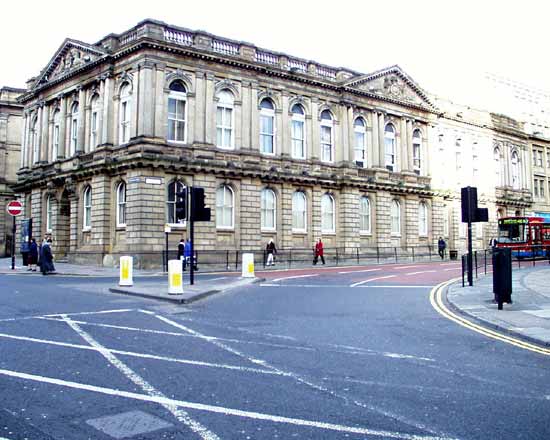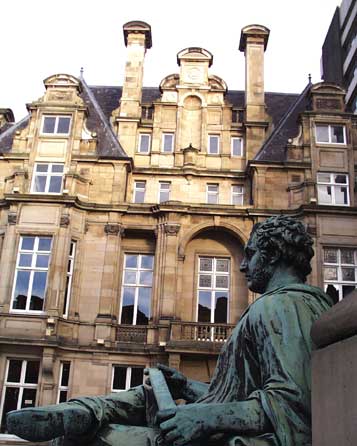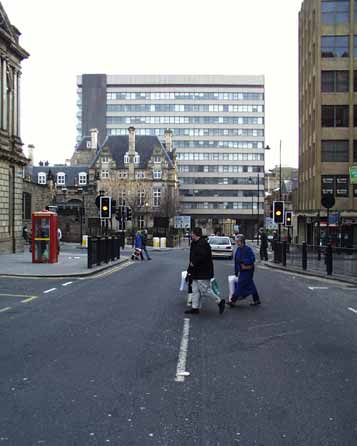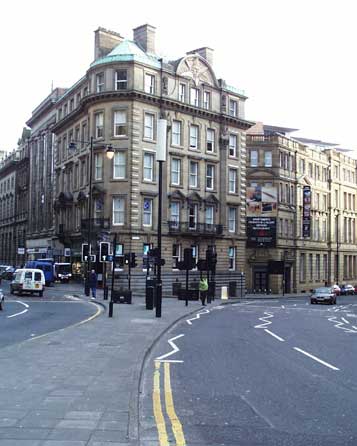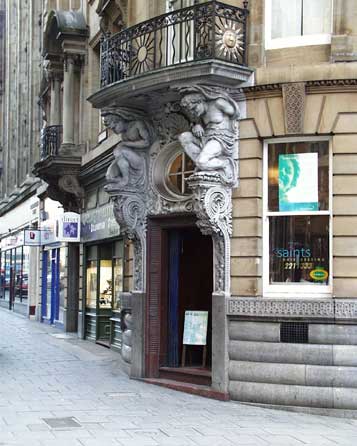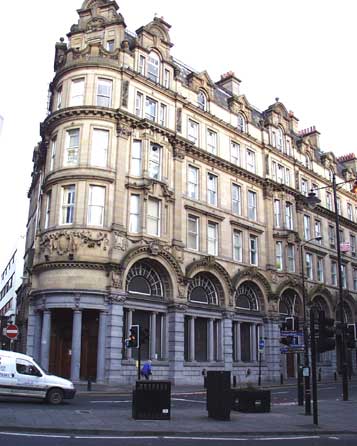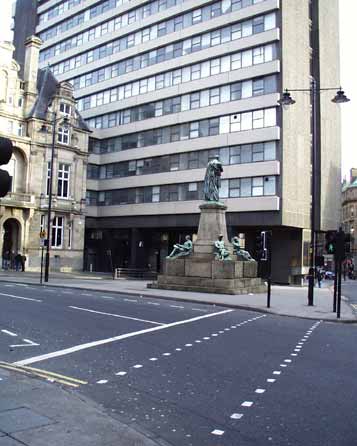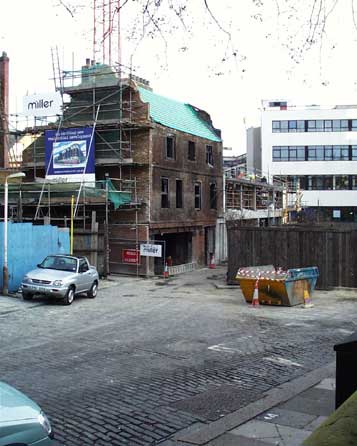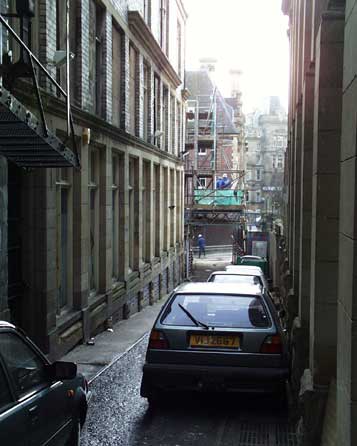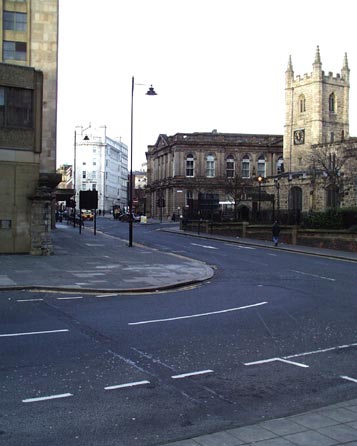 |
|
New bits
Sat. 16th Dec., 2000
|
 |
 |
|
During the prosperous latter part of the nineteenth century many fine buildings were erected in Newcastle. This is the Union
Club, whose French chateau style rose above Westgate Road in 1877. The architect was M. P. Manning.Stephenson's Monument looks on nearby, but the whole is dwarfed by a 1960s monstrosity, straddling the
road. Westgate House was paid for by the Norwich Union. It seems that we have Insurance companies to thank for four of the most atrocious and out of place buildings in the city. The others, the
Pearl Assurance
pile at Northumberland Street, the Sun Alliance sacrelage in Mosley Street replacing the old Town Hall, and the Commercial Union calamity in Pilgrim Street stand defiant. Westgate house is due for demolition.
This eastward view along Westgate Road shows the Union Club, now a magnificant Witherspoon bar, and the out of the box Westgate House behind. I cannot imagine of what the city Council were thinking in
granting planning permission for such an out of place and essentially obstuctive eyesore. |
|
|
|
|
|
 |
 |
 |
 |
|
Not all Insurance Company buildings are eyesores. This is the Sun Insurance building opened in 1904 and designed by Oliver
Leeson & Wood. This was one of the last jobs carried out by Thomas Oliver, who worked for John Dobson before moving to York to be responsible for some innovative railway work. He returned to Newcastle
when his father died in 1857 and practised here until his death in 1902.That magnificent sun looks down on Westgate Road, Collingwood Street is to the left of this building. On closer inspection that
sunburst has a rather sullen and sad expression. The mighty, yet human supports to the entrance are an imposing touch. This building lies in the shadow of Westgate House. Once the 1960s carbuncle is
removed this area, always the commercial and business heart of the city, will once again be on a consistent scale and humanity. Those supporting figures, whilst massive and well endowed with muscles are
not the human perfection of a Greek statue, but a reassuringly normal looking pair. They may have rather cherubic and young faces, but their bodies are sagging and worn in the way that we all get to know as
the years take their toll. |
|
|
Opposite the Sun Insurance building is the once Barclays International Bank, but
originally designed by Thomas Oliver as an Hotel in 1899. The bank took it over during construction and opened in 1903.Except for a brief and totally unsuccessful spell as a reastaurant and theme pub,
Collingwood Buildings has been empty since the bank moved out during the early 1980s. Its main hall is a wonderful tiled space with stout columns and an ornate painted ceiling. The upper floors are give
over to offices, some the original hotel rooms being combined to provide "open plan" that was so much in vogue from the 1960s. onward. |
|
|
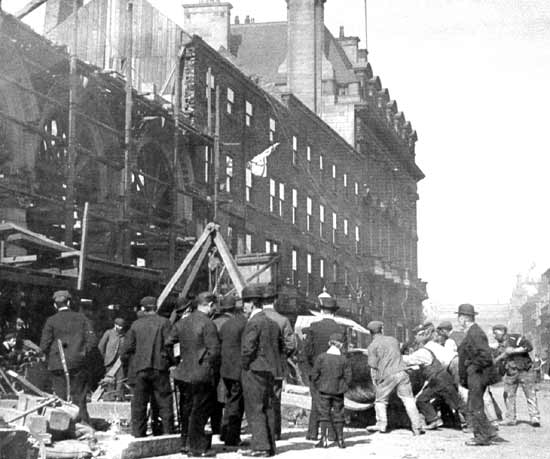 |
|
Photograph property of Newcastle upon Tyne Libraries |
 |
|
Here we see Collingwood Buildings under construction at the turn of the twentieth century. The splendid arched windows are visible over
the crowd who seem to be fascinated by the preparation of large pipes prior to being lowered under the structure by that pyramid armed block and tackle. This appears to be the work on the water supply rather than the
building itself which seems dormant at the time. This must have been during the period between the site being acquired by the bank and the work being taken over by their preferred firm, Cacket & Burns Dick.
|
|
|
 |
See how the horrid Westgate House stands as a barrier at this point.That lower section has lain empty for some years now,
having one been home to, amongst others, the North East Traffic Area Office for the Department of Transport. The road between Collingwood Buildings and the lower part of Westgate House is Pudding Chare,
leading to the rear of the Newcastle Chronicle Newspaper building, and onwards to Bigg Market. A small river, now hidden underground, flows beside the course of this narrow lane. Called the High or Pow
Dene it is thought that it gave its name to this winding lane. |
|
|
Here George Stephenson looks away from his grand station building towards Bolbec Hall and Mining Institute where he
demonstrated his revolutionary ideas that lead to the railway.You can see how he, and everything else in the vicinity, is dwarfed unnecessarily by Westgate House. Good riddance and hooray as it falls
under the demolisher's hammer ball. |
|
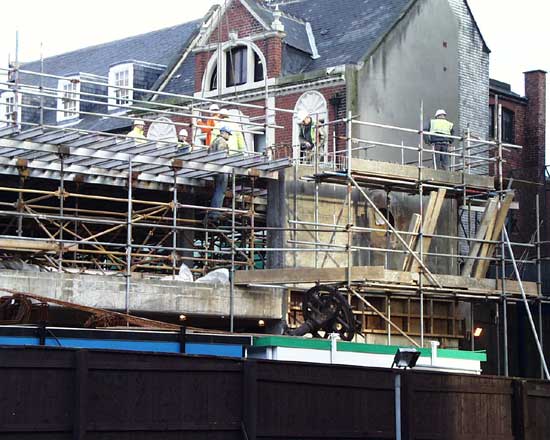 |
 |
|
Here along Pudding Chare new construction is taking place. Some derelict warehouses and small workshops are being replaced with
prestigious town housing. One original building is being kept, however. The small house adjacent to Rosemary Lane is being restored as part of the project. |
|
|
 |
 |
|
The white edifice in the background is the Chronicle Newspaper building. The lane leading from cobbled St. John's Street to
Pudding Chare is Rosemary Lane, as is the lane to the right from that rubbish skip, skirting the edge of St. John's Church ground.The artist's impression on the signboard shows town flats with a curved
corner at the Pudding Chare end, and a glazed roof section. It looks as if the new building will be about the same height as that old house. |
|
|
This is the southward view from the alley leading towards Rosemary Lane. The rear of the Union Club is beyond the
construction site at that old house gable end. Grainger's Station Hotel is just visible in the distance. |
|
|
 |
|
A short step away is this imposing construction, once the Trustee Savings Bank. Since July 2000 part of it has been occupied by the
regional office of the Go-Ahead transport group, following a disastrous fire in Cale Cross House, that black coffin like structure beside the Tyne Bridge.The Newcastle coat of arms on the front pediment and busy bees
on the side are fitting icons for the Newcastle Savings Bank, later to become Trustee Savings Bank. It is situated at the junction of Westgate Road and Grainger Street, running to the right. Just out of shot to
the right is St. John's Church. |
 |
 |
|
This view places St. John's on the right, the old TSB centre, the white Cross House in the distance, and on the left the corner of Douglas House, built by British Railways to house its eastern headquarters, but never used as such. On the corner is
the pillar and ball that marked the entrance of the Royal Grammar School that existed here then later the Virgin Mary Hospital, itself removed to Rye Hill in 1844.The remaining pillar was absorbed into
"The Express" public house until 1972 when the present building was erected. |
|
|
|
 |
|
|
 |
|
If you should arrive here via a search, or be missing the navigation on the left hand side, click this button.
|
|



